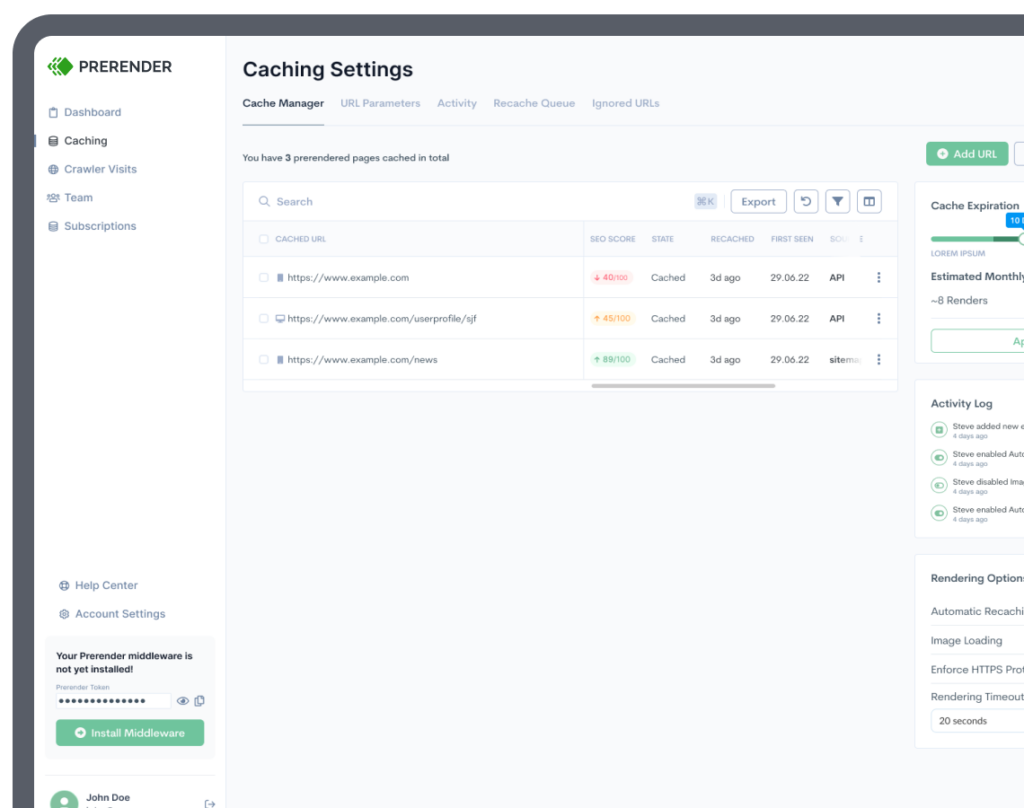Many websites are built with React JS. React allows web developers to build fast and responsive websites, even for large web applications.
However, the React application isn’t perfect either, especially when it comes to the initial load times and the SEO side effects for the client-side rendering (CSR) websites.
In this article, we’ll delve into React optimization techniques, pinpoint the bottlenecks responsible for user experience issues, and introduce dynamic rendering to make React websites go faster.
3 Techniques for Optimizing React Application Performance
Building a React website is like sculpting a masterpiece. You need to carefully craft each element to ensure that they work together seamlessly. However, even the most well-crafted code can face challenges when it comes to react page performance. These issues become even more pronounced in SPAs built with JavaScript.
Related: Learn how to improve the indexing performance of your SPAs.
Let’s take a look at some of the common React performance optimization techniques to understand the need for dynamic rendering better.
- Code splitting: This involves breaking down your application into smaller, manageable parts, enabling users to load only the necessary components, and reducing initial load times.
- Lazy loading: Loading the web components only when they are needed enhances the efficiency of your application.
- Minification and compression: With minification, you’re shrinking your codebase by removing unnecessary characters and spaces. Compressing assets also reduces the overall file size, facilitating faster downloads and rendering.
While these techniques can help you improve the performance of your React website, they don’t address the specific challenges associated with SPAs and SEO. SPAs download and execute massive JavaScript bundles, which can significantly delay the initial page load, leading to poor user experience.
This delay can also manifest as soft 404 errors—a condition where the server sends a 200 OK status code, but the page is empty as the content remains invisible due to JavaScript execution problems. Search engines also can’t crawl your website if it’s plagued by slow rendering, leading to indexation problems.
Other problems affect React JavaSript SPAs, but luckily, they can be solved with dynamic rendering solutions.
Dynamic Rendering for Healthier React SEO
Dynamic rendering is a game-changer for websites facing challenges related to JavaScript React SEO, user experience, and technical SEO performance.
At its core, dynamic rendering involves serving pre-rendered content to search engine bots while delivering the full, dynamic JavaScript experience to users. This approach ensures that search engines can easily index and understand the content, indirectly improving SEO rankings and better visibility in search results.
Key benefits of dynamic rendering include:
-
- Ensured indexability: Dynamic rendering guarantees that your pages are 100% indexed-ready, overcoming challenges posed by heavy JavaScript React usage.
- Reduced processing time: By presenting fully rendered pages to search engine bots, dynamic rendering eliminates the slow rendering problem (a typical issue of React JS websites.) This is particularly beneficial for large websites, as not only does this improve the indexing time and success rate, but also prevents crawl budget exhaustion.
- Enhanced user experience: Dynamic rendering serves a pre-rendered version of the content, leading to faster page load times and a smoother user experience, reducing the chances of encountering a “404 page not found” error.
Related: Follow this guide to resolve 404 errors on SPAs.
Dynamic rendering offers a powerful solution for addressing performance concerns in React applications while simultaneously bolstering SEO performance. One of the most efficient methods to seamlessly integrate dynamic rendering into React SEO strategy is by adopting Prerender.
How Prerender Makes React SEO Friendly
For apps built with React JS, Prerender is a powerful enterprise SEO tool. It is equipped with a dynamic rendering solution that can intelligently differentiate between bots and human users’ requests.
When bots visit your site, Prerender delivers the static HTML version of the page, providing a seamless crawling and indexing process. And when the requests come from human users, they will go to the normal route. This greatly improves the loading time and SEO, leading to higher Web Core Vitals scores and SERP rankings without compromising the user experience. Learn more about how Prerender works for JavaScript websites here.
And the benefits don’t stop there. Besides solving Javascript React problems, Prerender is also suitable for VueJS, AngularJS, and other popular JS frameworks. Prerender’s pricing system is also affordable, especially when compared to the cost of building SSR from scratch.
So if you have a React website and you want to solve your indexing and performance issues, try out Prerender!
How to Integrate Prerender in React Websites
Now that you understand how Prerender boosts React application performance, let’s dive into how to integrate this powerful solution with your React website.
There are two primary installation methods, each catering to different server architectures and needs. The backend integration offers more flexibility and control, while CDN integration simplifies the routing process.
Method 1: Integrated into the Backend Service using Prerender Integration
Before going to the integration steps, first, you need to select the Prerender integration that aligns with your backend language. Prerender supports various languages, including Node.js, C#, Python, PHP, Ruby, and more. See the Prerender’s full integration list here.
Second, you’d need to obtain your Prerender token. To do this, you can sign up for a Prerender account. Once done, you’ll be redirected to the Prerender dashboard, where you will find your API key at the top of the page.
Next, install the Prerender integration for your backend language. For example, for Node.js, you can install it using the following command:
npm install prerender-node –save
Finally, add the following line when setting up your express app:
app.use(require(‘prerender-node’).set(‘prerenderToken’, ‘YOUR_TOKEN’));
Method 2: Integrated into the CDN in Front of Your Servers
In this case, rather than using a Prerender integration, you will create rewrite rules that enable the routing of requests between your backend and Prerender’s cloud service. These rules should identify crawler requests and reroute them to Prerender for dynamic rendering.
Here’s an example of how to integrate Prerender with IIS.
For both methods, you can test your setup by running the following curl command:
curl -H “X-Prerender-Token: <YOUR_PRERENDER_TOKEN>” https://service.prerender.io/<YOUR_WEBSITE_URL>
For a detailed guide on how to install Prerender, visit this blog or this getting started documentation.
Accelerate React Page with Dynamic Rendering
Adopting Prerender’s dynamic rendering for your React-based website allows you to have the best of all worlds: an immersive user experience, speedy server response time (SRT), and optimized SEO performance. This way, you’re not only meeting current standards but also future-proofing your online presence.
Ready to supercharge your React website? Try Prerender today and see the difference for yourself.



